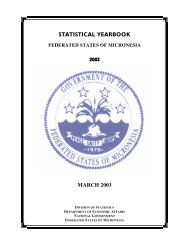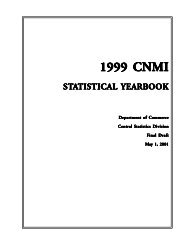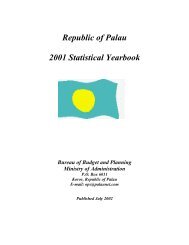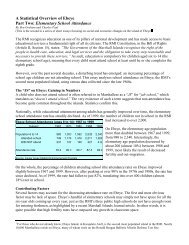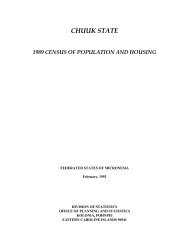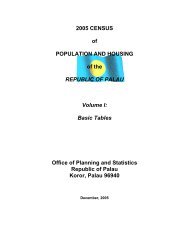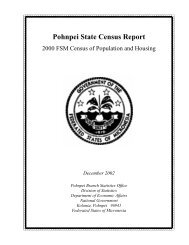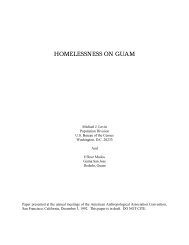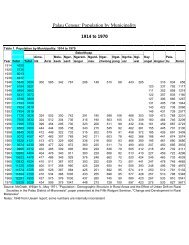Chapter 10. Industry and Occupation2000 FSM <strong>Census</strong> of <strong>Chuuk</strong> <strong>State</strong>16 and 29 percentage points, respectively. While financial intermediation and health decreased by 14 and 19percentage points, respectively.Table 10.3: Industry by Percent of Persons with High School Diploma and Vocational Training, <strong>Chuuk</strong> <strong>State</strong>: 1994 and 20001994 2000H.S. graduates & above Vocational training H.S. graduates & above Vocational trainingIndustry Total Males Females Total Males Females Total Males Females Total Males FemalesCurrent formal work force 15+ years 62.2 61.2 64.5 21.1 21.3 20.6 57.1 52.2 69.5 22.3 23.9 18.4Agriculture, forestry, fishing and quarrying 75.8 75.9 72.7 12.3 11.6 36.4 56.6 53.3 87.5 28.4 31.3 -Construction 41.4 41.1 44.4 11.8 12.6 - 20.0 19.6 33.3 3.2 1.8 5.4Gas, electricity and water supply 37.5 37.5 - 28.6 28.6 - 57.1 56.4 66.7 32.9 34.2 16.7Transportation and communication 59.5 56.8 77.3 21.1 21.0 22.2 52.1 50.5 70.0 15.9 16.4 -Manufacturing 48.3 50.0 45.2 12.1 11.8 12.8 20.7 20.4 21.2 9.1 9.7 8.3Wholesale and retail trade 48.2 48.0 48.4 13.7 19.2 7.3 39.7 29.3 54.7 11.9 17.2 8.7Hotels, restaurants, and bars 32.7 30.0 34.4 11.2 11.4 11.1 39.1 30.9 43.6 40.4 42.9 14.3Financial intermediation 85.2 90.9 78.6 48.4 52.9 42.9 96.9 100.0 92.9 34.4 33.3 35.7Real estate & business activities 60.5 58.5 65.2 23.8 22.4 26.9 66.7 67.3 63.6 37.1 42.0 16.7Health 71.2 73.1 69.0 39.1 39.7 38.5 73.6 66.9 79.7 20.1 20.3 19.1Education 76.7 76.3 77.3 21.9 21.9 21.8 82.9 81.8 84.7 26.3 29.6 20.8Public administration 55.6 52.9 70.1 23.3 23.3 23.1 48.9 44.8 68.4 38.5 38.8 38.2Other service activities 51.1 47.8 55.3 17.1 18.4 15.3 37.8 34.3 48.6 12.4 14.4 5.7Source: 1994 FSM <strong>Census</strong>, Table P115; 2000 FSM <strong>Census</strong>, Tables P2-12 and P2-13.Table 10.4 confirms an assumption that certain industries require larger proportions of certain occupations. First, as of2000, in extractive industries such as agriculture, forestry, fishing and quarrying, 32.1 percent of all occupations wereagriculture and fishing related. Likewise, in secondary industries such as construction, public utilities, andmanufacturing, there was a predominant occupational group –craft and related trades, machine operators, andelementary operators and laborers.Certain tertiary industries such as health, education, business and computer activities, and transportation andcommunication, require technicians, associate professionals, and administrative support. High percentages arerecorded in these industries by occupations for technicians, associate professionals, and administrative support. Oneparticular industry, often defined as a quaternary industry – tourism-related, such as hotels, restaurants and bars – found60.6 percent of its employees in the services occupation.Table 10.4: Industry by Occupation, <strong>Chuuk</strong> <strong>State</strong>: 1994 and 20001994 2000Executive Technic. Craft. Executive Technic. Craft.managers assoc. prof. Agric. repair managers assoc. prof. Agric. repairand Admin. Serv- and operators. and admin. Serv- and operators.Industry Total Percent prof. sup. ices fish. laborers Total Percent prof. sup. ices fish. laborersCurrent formal workforce 15+ years 5,373 100.0 21.8 34.9 16.2 3.0 24.1 4,546 100.0 35.6 24.2 17.1 1.1 22.1Agri., forest. fishing& mining 432 100.0 12.3 36.1 2.3 28.5 20.8 88 100.0 13.6 28.4 3.4 30.7 23.9Construction 136 100.0 6.6 7.4 1.5 - 84.6 113 100.0 3.5 5.3 0.9 - 90.3Gas/elect.&water supply 28 100.0 10.7 10.7 - - 78.6 85 100.0 10.6 10.6 1.2 - 77.6Transp. & comm. 194 100.0 9.3 35.1 6.2 - 49.5 245 100.0 9.4 31.4 11.8 0.4 46.9Manufacturing 107 100.0 12.1 20.6 21.5 3.7 42.1 94 100.0 5.3 6.4 11.7 - 76.6Wholesale & retail trad 380 100.0 6.8 44.2 12.9 0.3 35.8 503 100.0 7.6 38.2 17.1 0.8 36.4Hotels, rest. & bars 187 100.0 6.4 18.2 47.6 - 27.8 168 100.0 5.4 21.4 41.1 2.4 29.8Financial intermediation 62 100.0 17.7 62.9 8.1 3.2 8.1 32 100.0 34.4 59.4 3.1 - 3.1Real estate/busin. activ. 84 100.0 17.9 35.7 6.0 - 40.5 62 100.0 37.1 17.7 11.3 - 33.9Health 363 100.0 62.0 24.2 5.5 - 8.3 273 100.0 45.1 42.1 5.5 - 7.3Education 1,369 100.0 25.1 49.1 19.1 0.1 6.6 1,116 100.0 72.5 13.1 6.3 0.1 8.1Public administration 1,435 100.0 25.9 25.7 22.0 1.5 25.0 1,614 100.0 32.5 26.5 27.4 0.6 13.1Other services/activities 597 100.0 12.1 36.2 12.8 1.5 37.2 153 100.0 18.3 19.0 26.8 1.3 34.6Source: 1994 FSM <strong>Census</strong>, Table P129; 2000 FSM <strong>Census</strong>, Table P8-14.OccupationTable 10.5 presents data on occupations of current formal work force in 1994 and 2000. From 1994 to 2000, only twooccupations showed a percentage increase in numbers of economically active. The largest occupation group was thatof professionals, with a 1994-2000 increase of 49.7 percent, followed by executives and managers (15.3 percentincrease in number of persons). All other occupations experienced negative changes with the biggest loss in agricultureand fishing workers (- 69.6 percent). A particular reason may be that in the early 1990s Ting Hong fishing companywas operating in <strong>Chuuk</strong>, and its employment was reported in the 1994 <strong>Census</strong>. However, in the late 1990s, Ting Hongwas no longer operating in <strong>Chuuk</strong>, and its employment of fishing workers plummeted.94 <strong>Chuuk</strong> Branch Statistics Office, Division of Statistics, FSM Department of Economic Affairs
2000 FSM <strong>Census</strong> of <strong>Chuuk</strong> <strong>State</strong>Chapter 10. Industry and OccupationTable 10.5: Occupations of Current formal Work Force, <strong>Chuuk</strong> <strong>State</strong>: , 1994 and 2000Number Percent Change NumberOccupation 1994 2000 1994-2000 1994 2000Current formal workforce 15+ years 5,373 4,546 (15.4) 100.0 100.0Executive and managers 393 453 15.3 7.3 10.0Professionals 778 1,165 49.7 14.5 25.6Technical and associate professionals 1,046 575 (45.0) 19.5 12.6Administrative support 829 523 (36.9) 15.4 11.5Service workers 868 776 (10.6) 16.2 17.1Agric. and fishing workers 161 49 (69.6) 3.0 1.1Craft and related workers 444 304 (31.5) 8.3 6.7Machine operators 314 289 (8.0) 5.8 6.4Elementary occupations and laborers 539 412 (23.6) 10.0 9.1Armed Forces 1 - - - -Source: 1980 TTPI <strong>Census</strong>, Table T123; 1994 FSM <strong>Census</strong>, Table P28; 2000 FSM <strong>Census</strong>, Table P2-16Note: 1980 data are for individuals 16 years and over.Of all employed persons who replied to their occupation in 2000, 71.7 percent were males and 28.3 percent werefemales (Table 10.6). Exceedingly high percentages of males were found in certain occupations – 95.6 percent asagriculture and fishing workers, 94.1 percent as machine operators, 93.4 percent as craft and related workers, and 92.7percent as executives and managers. The only occupation in which females were in the majority was administrativesupport (26.4 percent males and 73.6 percent females).However, when 1994 and 2000 percentages are compared, there is some evidence of women’s equity and viableopportunities in the work force. Although four of 9 occupational groups increased for males percentage-wise, the fiveremaining groups in which women gained more employability increased as well. They are as follows: professionals(31.percent in 1994 up to 38.1percent in 2000), as administrative support (71.4 percent in 1994 up to 73.6 percent in2000), as agriculture and fishing workers (1.2 percent in 1994 up to 4.1percent in 2000), as machine operators(3.5percent in 1994 up to 5.9percent in 2000), and as elementary occupations and laborers (10.2percent in 1994 up to16.7percent in 2000).Table 10.6: Occupations of Current Work Force for Aged 15 Years and Over Who Worked in 5 Years Previous to <strong>Census</strong> by Sex, <strong>Chuuk</strong> <strong>State</strong>: 1994 and 20001994 2000Number Percent Number PercentOccupation Total Males Females Total Males Females Total Males Females Total Males FemalesCurrent formal workforce 15+ years 5,373 3,828 1,545 100.0 71.2 28.8 4,546 3,261 1,285 100.0 71.7 28.3Executive and managers 393 344 49 100.0 87.5 12.5 453 420 33 100.0 92.7 7.3Professionals 778 530 248 100.0 68.1 31.9 1,165 721 444 100.0 61.9 38.1Technical and associate professionals 1,046 767 279 100.0 73.3 26.7 575 426 149 100.0 74.1 25.9Administrative support 829 237 592 100.0 28.6 71.4 523 138 385 100.0 26.4 73.6Service workers 868 618 250 100.0 71.2 28.8 776 610 166 100.0 78.6 21.4Agric. and fishing workers 161 159 2 100.0 98.8 1.2 49 47 2 100.0 95.9 4.1Craft and related workers 444 385 59 100.0 86.7 13.3 304 284 20 100.0 93.4 6.6Machine operators 314 303 11 100.0 96.5 3.5 289 272 17 100.0 94.1 5.9Elementary occupations and laborers 539 484 55 100.0 89.8 10.2 412 343 69 100.0 83.3 16.7Armed Forces … … - … … - - - - - - -Source: 1994 FSM <strong>Census</strong>, Table P28; 2000 FSM <strong>Census</strong>, Table P2-16.Table 10.7 presents occupational data by age group in 1994 and 2000, and the most outstanding finding is that thelargest percentages in most occupations were found in the older age groups, especially 35 years and older.Nevertheless, the age group 25-34 years predominated agriculture and fishing workers in 2000, and administrativesupport, agriculture and fishing workers and elementary occupations and laborers in 1994.If the two highest percentages in each occupation (excluding armed forces) are added together as one age group, then in1994 the workers 25-34 years were high in six occupational groups (except executives and managers, professionals,and technical and associate professionals) and the workers 35-44 years were high in eight occupational groups (exceptcraft and related workers and elementary occupations and laborers). In 2000, the workers 25-34 years were high inonly five occupational groups (except executives and managers, professionals, technical and associate professionals,and craft and related workers), and the workers 35-44 years were still high in nine occupational groups (exceptagriculture and fishing workers and administrative support). Also, in 2000, the workers 45-64 years were high in fiveoccupational groups (except administrative support, service workers, agriculture and fishing workers, and machineworkers). Surprisingly, in 1994, the workers 15-24 years were high in agriculture and fishing workers as opposed to65+ in 2000. It would appear that agriculture and fishing occupations lost favor among the younger workers, and wereleft to the very oldest workers.<strong>Chuuk</strong> Branch Statistics Office, Division of Statistics, FSM Department of Economic Affairs 95
- Page 5:
iii
- Page 12 and 13:
Preface2000 FSM Census of Chuukx
- Page 14 and 15:
Table of contents2000 FSM Census of
- Page 16 and 17:
LIST OF TEXT TABLESTABLEPageChapter
- Page 18 and 19:
List of Text Table2000 FSM Census o
- Page 20 and 21:
LIST OF FIGURESFIGUREPageFigure 1.1
- Page 22 and 23:
List of Basic-Tables2000 FSM Census
- Page 24 and 25:
MAP OF FSMxxiiChuuk Branch Statisti
- Page 27 and 28:
2000 FSM Census of Chuuk StateExecu
- Page 29 and 30:
CHAPTER 1INTRODUCTIONThe creation o
- Page 31 and 32:
2000 FSM Census of Chuuk StateChapt
- Page 33 and 34:
2000 FSM Census of Chuuk StateChapt
- Page 35 and 36:
2000 FSM Census of Chuuk StateChapt
- Page 37 and 38:
2000 FSM Census of Chuuk StateChapt
- Page 39 and 40:
2000 FSM Census of Chuuk StateChapt
- Page 41 and 42:
2000 FSM Census of Chuuk StateChapt
- Page 43 and 44:
2000 FSM Census of Chuuk State Chap
- Page 45:
2000 FSM Census of Chuuk StateChapt
- Page 48 and 49:
Chapter 2. Age and Sex Structure200
- Page 50 and 51:
Chapter 2. Age and Sex Structure200
- Page 52 and 53:
Chapter 2. Age and Sex Structure200
- Page 55 and 56:
CHAPTER 3HOUSEHOLDS, FAMILIES, AND
- Page 57 and 58:
2000 FSM Census of Chuuk StateChapt
- Page 59 and 60:
2000 FSM Census of Chuuk StateChapt
- Page 61:
2000 FSM Census of Chuuk StateChapt
- Page 64 and 65:
Chapter 4. Fertility2000 FSM Census
- Page 66 and 67:
Chapter 4. Fertility2000 FSM Census
- Page 68 and 69:
Chapter 4. Fertility2000 FSM Census
- Page 71 and 72: CHAPTER 5MORTALITYIntroductionAs re
- Page 73 and 74: 2000 FSM Census of Chuuk StateChapt
- Page 75: 2000 FSM Census of Chuuk StateChapt
- Page 78 and 79: Chapter 6. Migration2000 FSM Census
- Page 80 and 81: Chapter 6. Migration2000 FSM Census
- Page 82 and 83: Chapter 6. Migration2000 FSM Census
- Page 84 and 85: Chapter 6. Migration2000 FSM Census
- Page 86 and 87: Chapter 7. Religion, Ethnicity, and
- Page 88 and 89: Chapter 7. Religion, Ethnicity, and
- Page 90 and 91: Chapter 7. Religion, Ethnicity, and
- Page 92 and 93: Chapter 8. Education2000 FSM Census
- Page 94 and 95: Chapter 8. Education2000 FSM Census
- Page 96 and 97: Chapter 8. Education2000 FSM Census
- Page 98 and 99: Chapter 8. Education2000 FSM Census
- Page 100 and 101: Chapter 8. Education2000 FSM Census
- Page 103 and 104: CHAPTER 9ECONOMIC ACTIVITYIntroduct
- Page 105 and 106: 2000 FSM Census of Chuuk StateChapt
- Page 107 and 108: 2000 FSM Census of Chuuk StateChapt
- Page 109 and 110: 2000 FSM Census of Chuuk StateChapt
- Page 111 and 112: 2000 FSM Census of Chuuk StateChapt
- Page 113 and 114: 2000 FSM Census of Chuuk StateChapt
- Page 115 and 116: 2000 FSM Census of Chuuk StateChapt
- Page 117 and 118: CHAPTER 10INDUSTRY AND OCCUPATIONIn
- Page 119 and 120: 2000 FSM Census of Chuuk StateChapt
- Page 121: 2000 FSM Census of Chuuk StateChapt
- Page 125 and 126: 2000 FSM Census of Chuuk StateChapt
- Page 127 and 128: 2000 FSM Census of Chuuk StateChapt
- Page 129 and 130: CHAPTER 11INCOMEIntroductionThe 200
- Page 131 and 132: 2000 FSM Census of Chuuk StateChapt
- Page 133 and 134: 2000 FSM Census of Chuuk StateChapt
- Page 135 and 136: 2000 FSM Census of Chuuk StateChapt
- Page 137: 2000 FSM Census of Chuuk StateChapt
- Page 140 and 141: Chapter 12. Housing2000 FSM Census
- Page 142 and 143: Chapter 12. Housing2000 FSM Census
- Page 144 and 145: Chapter 12. Housing2000 FSM Census
- Page 146 and 147: Chapter 12. Housing2000 FSM Census
- Page 148 and 149: Chapter 12. Housing2000 FSM Census
- Page 150 and 151: Chapter 12. Housing2000 FSM Census
- Page 152 and 153: Chapter 12. Housing2000 FSM Census
- Page 154: Chapter 12. Housing2000 FSM Census
- Page 157 and 158: BIBLIOGRAPHYArriaga, E.E., (1983).
- Page 159: 2000 FSM Census of Chuuk StateBibli
- Page 162 and 163: Basic Tables2000 FSM Census of Chuu
- Page 164 and 165: Basic Tables2000 FSM Census of Chuu
- Page 166 and 167: Basic Tables2000 FSM Census of Chuu
- Page 168 and 169: Basic Tables2000 FSM Census of Chuu
- Page 170 and 171: Basic Tables2000 FSM Census of Chuu
- Page 172 and 173:
Basic Tables2000 FSM Census of Chuu
- Page 174 and 175:
Basic Tables2000 FSM Census of Chuu
- Page 176 and 177:
Basic Tables2000 FSM Census of Chuu
- Page 178 and 179:
Basic Tables2000 FSM Census of Chuu
- Page 180 and 181:
Basic Tables2000 FSM Census of Chuu
- Page 182 and 183:
Basic Tables2000 FSM Census of Chuu
- Page 184 and 185:
Basic Tables2000 FSM Census of Chuu
- Page 186 and 187:
Basic Tables2000 FSM Census of Chuu
- Page 188 and 189:
Basic Tables2000 FSM Census of Chuu
- Page 190 and 191:
Basic Tables2000 FSM Census of Chuu
- Page 192 and 193:
Basic Tables2000 FSM Census of Chuu
- Page 194 and 195:
Basic Tables2000 FSM Census of Chuu
- Page 196 and 197:
Basic Tables2000 FSM Census of Chuu
- Page 198 and 199:
Basic Tables2000 FSM Census of Chuu
- Page 200 and 201:
Basic Tables2000 FSM Census of Chuu
- Page 202 and 203:
Basic Tables2000 FSM Census of Chuu
- Page 204 and 205:
Basic Tables2000 FSM Census of Chuu
- Page 206 and 207:
Basic Tables2000 FSM Census of Chuu
- Page 208 and 209:
Basic Tables2000 FSM Census of Chuu
- Page 210 and 211:
Basic Tables2000 FSM Census of Chuu
- Page 212 and 213:
Basic Tables2000 FSM Census of Chuu
- Page 214 and 215:
Basic Tables2000 FSM Census of Chuu
- Page 216 and 217:
Basic Tables2000 FSM Census of Chuu
- Page 218 and 219:
Basic Tables2000 FSM Census of Chuu
- Page 220 and 221:
Basic Tables2000 FSM Census of Chuu
- Page 222 and 223:
Basic Tables2000 FSM Census of Chuu
- Page 224 and 225:
Basic Tables2000 FSM Census of Chuu
- Page 226 and 227:
Basic Tables2000 FSM Census of Chuu
- Page 228 and 229:
Basic Tables2000 FSM Census of Chuu
- Page 230 and 231:
Basic Tables2000 FSM Census of Chuu
- Page 232 and 233:
Basic Tables2000 FSM Census of Chuu
- Page 234 and 235:
Basic Tables2000 FSM Census of Chuu
- Page 236 and 237:
Basic Tables2000 FSM Census of Chuu
- Page 238 and 239:
Basic Tables2000 FSM Census of Chuu
- Page 240 and 241:
Basic Tables2000 FSM Census of Chuu
- Page 242 and 243:
Basic Tables2000 FSM Census of Chuu
- Page 244 and 245:
Basic Tables2000 FSM Census of Chuu
- Page 246 and 247:
Basic Tables2000 FSM Census of Chuu
- Page 248 and 249:
Basic Tables2000 FSM Census of Chuu
- Page 250 and 251:
Basic Tables2000 FSM Census of Chuu
- Page 252 and 253:
Basic Tables2000 FSM Census of Chuu
- Page 254 and 255:
Basic Tables2000 FSM Census of Chuu
- Page 256 and 257:
Basic Tables2000 FSM Census of Chuu
- Page 258 and 259:
Basic Tables2000 FSM Census of Chuu
- Page 260 and 261:
Basic Tables2000 FSM Census of Chuu
- Page 262 and 263:
Basic Tables2000 FSM Census of Chuu
- Page 264 and 265:
Basic Tables2000 FSM Census of Chuu
- Page 266 and 267:
Basic Tables2000 FSM Census of Chuu
- Page 268 and 269:
Basic Tables2000 FSM Census of Chuu
- Page 270 and 271:
Basic Tables2000 FSM Census of Chuu
- Page 272 and 273:
Basic Tables2000 FSM Census of Chuu
- Page 274 and 275:
Basic Tables2000 FSM Census of Chuu
- Page 276 and 277:
Basic Tables2000 FSM Census of Chuu
- Page 278 and 279:
Basic Tables2000 FSM Census of Chuu
- Page 280 and 281:
Basic Tables2000 FSM Census of Chuu
- Page 282 and 283:
Basic Tables2000 FSM Census of Chuu
- Page 284 and 285:
Basic Tables2000 FSM Census of Chuu
- Page 286 and 287:
Basic Tables2000 FSM Census of Chuu
- Page 288 and 289:
Basic Tables2000 FSM Census of Chuu
- Page 290 and 291:
Basic Tables2000 FSM Census of Chuu
- Page 292 and 293:
Questionnaire2000 FSM Census of Chu
- Page 294 and 295:
Questionnaire2000 FSM Census of Chu
- Page 296 and 297:
Questionnaire2000 FSM Census of Chu



